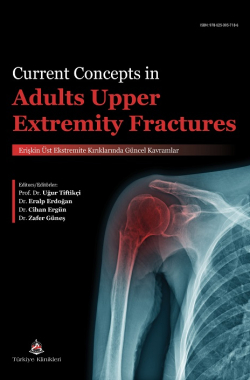PROXIMAL FOREARM FRACTURES:ANATOMY, EPIDEMIOLOGY AND CLASSIFICATION OF PROXIMAL ULNAR FRACTURES
Ahmet Günay Adam
Ankara Training and Research Hospital, Department of Orthopedics and Traumatology, Ankara, Türkiye
Adam AG. Proximal Forearm Fractures: Anatomy, Epidemiology and Classification of Proximal Ulnar Fractures. In: Tiftikçi U, Erdoğan E, Ergün C, Güneş Z, editors. Current Concepts in Adults Upper Extremity Fractures. 1st ed. Ankara: Türkiye Klinikleri; 2025. p.145-149.
ABSTRACT
The proximal ulna is crucial for elbow joint stability and movement, encompassing three primary joints: the radioulnar, radiocapitellar, and ulnohumeral joints. The joint dynamics are facilitated by the small sigmoid notch and radial head, which form a pivot-type synovial joint, allowing for significant pronation and supination. Key stabilizing structures include the annular ligament that encircles the radial head and tightens during movement. Anatomically, the olecranon resides posteriorly, while the coronoid process is anterior, creating a hinge-type ulnohumeral joint that permits extensive flexion and extension. Research indicates that the ulnohumeral joint enables 130-154 degrees of flexion and has a cartilage-free area critical for surgical considerations. The coronoid process acts as a primary restraint against posterior dislocation, while the olecranon prevents anterior dislocation. Static stabilizers such as the medial collateral ligament and lateral complex play vital roles against valgus and varus stresses, respectively.
Proximal ulna fractures encompass coronoid and olecranon fractures, representing a significant percentage of forearm injuries, frequently arising from low-energy falls and more common in individuals over 70, often associated with osteoporosis. Classification systems for these fractures, including Colton, AO, and Mayo classifications, assist in treatment decisions and healing evaluations. Regan and Morrey’s classification of coronoid fractures emphasizes the fracture line’s position, while O’Driscoll’s approach introduces detailed anatomical considerations using computed tomography. Understanding the complexities of the proximal ulna’s anatomy and associated injuries is essential for effective diagnosis, management, and rehabilitation of elbow-related conditions.
Keywords: Olecranon; Coronoid process; Classification; Anatomy; Elbow joint
Kaynak Göster
Referanslar
- Alcid JG, Ahmad CS, Lee TQ. Elbow anatomy and structural biomechanics. Clin Sports Med 2004;23(4):503-517, vii [Crossref] [PubMed]
- Martin S, Sanchez E. Anatomy and biomechanics of the elbow joint. Semin Musculoskelet Radiol. 2013;17(5):429-36. [Crossref] [PubMed]
- Ting FSH, Huang A, Potra R, Ferreira L, King GJW. Morphology of Proximal Ulna Bare Area: A Guide for Olecranon Osteotomy. J Hand Surg Am. 2024;49(3):281.e1-281.e5. [Crossref] [PubMed]
- Chapleau J, Canet F, Petit Y, Laflamme GY, Rouleau DM. Validity of goniometric elbow measurements: comparative study with a radiographic method. Clin Orthop Relat Res. 2011;469:3134-3140. [Crossref] [PubMed] [PMC]
- 2. Steinmann SP. Coronoid process fracture. J Am Acad Orthop Surg. 2008;16(9): 519e529. [Crossref] [PubMed]
- Hak DJ, Golladay GJ. Olecranon fractures: treatment options. J Am Acad Orthop Surg. 2000;8(4):266e275. [Crossref] [PubMed]
- Tribst MF, Zoppi A, Camargo JC, Sassi D, de Carvalho AE. Anatomical and functional study of the medial collateral ligament complex of the elbow. Acta Ortop Bras. 2012;20(6):334-8. [Crossref] [PubMed] [PMC]
- Noriego D, Carrera A, Tubbs RS, Guibernau J, San Millán M, Iwanaga J, Cateura A, Sañudo J, Reina F. The lateral ulnar collateral ligament: Anatomical and structural study for clinical application in the diagnosis and treatment of elbow lateral ligament injuries. Clin Anat. 2023;36(6):866-874. [Crossref] [PubMed]
- Rouleau DM, Faber KJ, Athwal GS. The proximal ulna dorsal angulation: a radiographic study. J shoulder elbow surg 2010;19(1):26-30. [Crossref] [PubMed]
- Rouleau DM, Canet F, Chapleau J, Petit Y, Sandman E, Faber KJ, Athwal GS. The influence of proximal ulnar morphology. 2012.
- Chapleau J, Balg F, Harvey EJ, Ménard J, Vauclair F, Laflamme GY, Hebert-Davies J, Rouleau DM. Impact of olecranon fracture malunion: Study on the importance of PUDA (Proximal Ulna Dorsal Angulation). Injury. 2016;47(11):2520-2524. [Crossref] [PubMed]
- Sandman E, Canet F, Petit Y, Laflamme GY, Athwal GS, Rouleau DM. Radial head subluxation following malalignment of the proximal ulna: a biomechanical study. J Orthop Trauma. 2013;28(8):464-9. [Crossref] [PubMed]
- Puchwein P, Schildhauer TA, Schöffmann S, Heidari N, Windisch G, Pichler W. Three-dimensional morphometry of the proximal ulna: a comparison to currently used ana tomically preshaped ulna plates. J Shoulder Elbow Surg. 2012;21(8):1018-23. [Crossref] [PubMed]
- Beşer CG, Demiryürek D, Özsoy H, Erçakmak B, Hayran M, Kızılay O, Özsoy A. Redefining the proximal ulna anatomy. Surg Radiol Anat. 2014;36(10):1023-31. [Crossref] [PubMed]
- Duckworth AD, Clement ND, Aitken SA, Court-Brown CM, McQueen MM: The epidemiology of fractures of the proximal ulna. Injury 2012;43(3):343 346. [Crossref] [PubMed]
- Court-Brown CM, Aitken SA, Forward D, O'Toole RV. The epidemiology of adult fractures. In: Bucholz RW, CourtBrown CM, Heckman JD, et al. editors. Rock wood and Green's fractures in adults. Philadelphia, PA: Lippincott Williams & Wilkins; 2010:53-84.
- Wells J, Ablove RH. Coronoid fractures of the elbow. Clin Med Res 2008;6:40-4. [Crossref] [PubMed] [PMC]
- Colton CL. Fractures of the olecranon in adults: classification and management. Injury. 1973;5:121-129. [Crossref] [PubMed]
- Cabanela ME, Morrey BF. The Elbow and Its Disorders. 2nd ed. Philadelphia, PA, USA: WB Saunders; 1993.
- Morrey BF. Current concepts in the treatment of fractures of the radial head, the olecranon, and the coronoid. Instr Course Lect. 1995;44:175-185. [Crossref] [PubMed]
- Regan W, Morrey B: Fractures of the coronoid process of the ulna. J Bone Joint Surg Am. 1989;71(9):1348-1354. [Crossref]
- O'Driscoll SW, Jupiter JB, Cohen MS, Ring D, McKee MD: Difficult elbow fractures: Pearls and pitfalls. Instr Course Lect. 2003;52:113-134.

